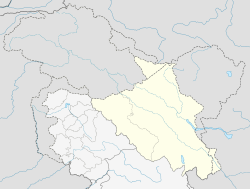Thang Dhothang, Thanga Chathang | |
|---|---|
Village | |
| Coordinates: 34°55′34″N76°47′42″E / 34.926°N 76.795°E | |
| Country | |
| Union Territory | Ladakh |
| District | Leh |
| Tehsil | Nubra |
| Population (2011) | |
• Total | 103 |
| Time zone | UTC+5:30 (IST) |
| PIN | 194401 |
| Census code | 911 |
Thang (also called Dhothang, Thanga Chathang) is a small village in the Leh district of Ladakh, India. [1] It is in the historical Chorbat region of Baltistan, divided between India and Pakistan by the 1972 Line of Control. Thang is part of the Nubra tehsil and the Turtuk community development block. It is twinned with the village of Frano, Gilgit-Baltistan.
Contents
The village was seized from Pakistan along with three other villages in the area as a result of the Indo-Pakistani War of 1971. It is 2.5 kilometers from the Line of Control. [2] The area's population is largely Balti. [3]




